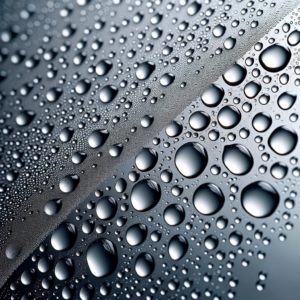The place for nano coating
Having trouble finding the right nano coating? We are here to help! Find high quality products for low prices here.
Nanocoating is a revolutionary technology that is increasingly used to protect everyday objects from damage. This ultra-thin coating, which is only a few nanometers thick, is made of special materials such as carbon or silicon and is applied to a surface using spraying techniques. This gives the surface an invisible protective layer that is water and dirt-repellent and extends the life of the product. Nano coating is increasingly used in various industries, from the automotive industry to the construction sector. Thanks to this technology, products remain in good condition for longer and consumers and companies save money on replacement and repairs.
Are you looking for a protective coating with dirt, stain and water repellent properties?
Then choose a nano coating.
The latest nano coatings offer effective protection against water, dirt, moisture and damage for almost every industry. Particularly effective in the automotive industry, in the food sector, in keeping clean and protecting large glass and frameworks, in the shipping industry and for protecting luxury yachts, wherever you look, nano coatings can be found.
The use of nano coatings offers many advantages. The most impressive at a glance:
- The use of nano coatings reduces maintenance and cleaning costs.
- It extends the life of large and small objects and protects them from decay. Think of bridges, major infrastructure works and monuments.
- Nano coatings offer effective and long-lasting protection against vandalism such as graffiti sprayers and urinators.
- When applied to electrical and electronic systems, the nano coatings reduce the risk of short circuits.
- The use of nano coatings protects the surface against bacteria, germs and fungi. Algae growth and atmospheric deposits are also prevented.
- The biggest advantage of nanocoatings is that they do not form an extra layer on the surface of the treated object, but due to their microscopic dimensions, they penetrate deep into the treated object or surface and become, as it were, one with the structure. This makes it impossible for liquids and contamination from outside to penetrate or adhere to the surface.
When choosing one of the many types of nano coatings, it is important to determine exactly your purpose. Where are you going to apply the nano coatings, what do you want to achieve with them and what result are you aiming for?
A number of objectives are possible:
- Moisture and dirt resistance
- Promote the self-cleaning properties of the object or surface
- Increasing the impact resistance of the object/surface and protection against damage
- Protects textile, leather and more against stains
Nano coating articles
Water repellent spray articles
Ceramic coating articles
Glass coating articles
Moisture and dirt resistance coating
Applying the right type of nano coating gives the surface or object oleophobic and hydrophobic properties. This means that it is impossible for water and dirt to adhere to the treated surface. There are many types of oleophobic and hydrophobic nano coatings and all have a hygienic, dirt and moisture-repellent effect, which is why they are often used on bathroom floors, walls and tiles, but also when making (outdoor) furniture from untreated types of wood such as scaffolding wood.
Hydrophobic and oleophobic coatings are also particularly suitable for glass and windows.
Self-cleaning properties
Hydrophilic nano coatings are most suitable for activating a self-cleaning effect of the surface. These are generally nano coatings based on titanium dioxide and are particularly suitable for application on surfaces with a smooth structure. The water-attracting properties of this type of nano coatings create a super-thin moisture filter on the treated objects with a strong self-cleaning effect. In practice, this means that atmospheric contaminants and all types of dirt slide off the object and do not have a chance to adhere to the surface.
Hydrophilic nano coatings are often applied to:
- solar panels
- windows of tall buildings and skyscrapers
- conservatories
- greenhouses
- medical instruments/laboratory equipment
Protection against damage and impact resistance
To achieve these results, glass and ceramic nano coatings are used. These are generally composed of silicon dioxide-based active ingredients in higher doses. This type of nano coatings is also known by a popular collective name ‘liquid glass’.
Glass and ceramic nano coatings are extremely hard and protect the surface against blows, bumps and damage. Because of these excellent protective properties, they are often used in the automotive industry and as a top layer for walls and floors. Glass and ceramic coatings are also successfully used to make machines and production equipment more sustainable.
Which coating adheres best to your surface or object?
Once you have determined what result you want to achieve with the application of nano coatings, it is time to choose from the many variants. Which nano coating is best suited for your specific surface and will adhere best to it? Not every nano coating adheres equally strongly to every surface.
The special chemical additives to different types of nano coatings ensure optimal adhesion to various surfaces. Some types adhere better to porous surfaces such as concrete, others are specially formulated to adhere to smooth surfaces such as car paint, others to stone and mineral surfaces.
It is therefore very important that when choosing nano coatings, you first carefully determine the type of surface to which they should adhere. If you fail to do this, there is a chance that you will not achieve the optimal desired result after coating.
Buy and applying the nano coating of your choice
Have you chosen a certain type of nano coating but do you still have questions? Do you want advice about reliable and expert suppliers?
Contact one of our expert coating specialists and we will be happy to help you with your choice. You can also visit our webshop for a number of selected products.
If you decide to entrust the application of your chosen nano coating to experienced applicators, we will be happy to advise you on your choice. We have years of experience in the coatings industry and are happy to help you choose a supplier or applicator that best suits your assignment and can offer an excellent customized service.
Important tips to help you choose nano coatings
In addition to the above things that you should take into account when purchasing and applying nano coatings, there are a number of things that you should take into account when you have decided to use nano coatings:
- Nano coatings must be applied to very clean, carefully cleaned surfaces.
- Nano coatings don’t work forever. Some types lose their effectiveness quite quickly and need to be replaced. Therefore, always consult an expert carefully.
- Nano coatings are not resistant to aggressive cleaning agents.
- Not every nano coating fits and adheres to every surface.
- An enormous amount of nano coatings are offered, sometimes with not very clear names. The same product may appear under different names.
- Therefore, please inquire with an expert and reliable advisor about the exact properties and operation.
Nano coatings, innovative and environmentally friendly
The use of nanoparticles offers room for experiments and new developments. One of the largest suppliers of nanoparticle-based products, Chemona, uses nanoparticles in its latest innovations. The nano product Polish & Coat uses the latest developments in nanotechnology and is used, among other things, on sailing ships.
Nanotechnology is often applied in developing antibacterial coatings used in hospitals and health centers.

